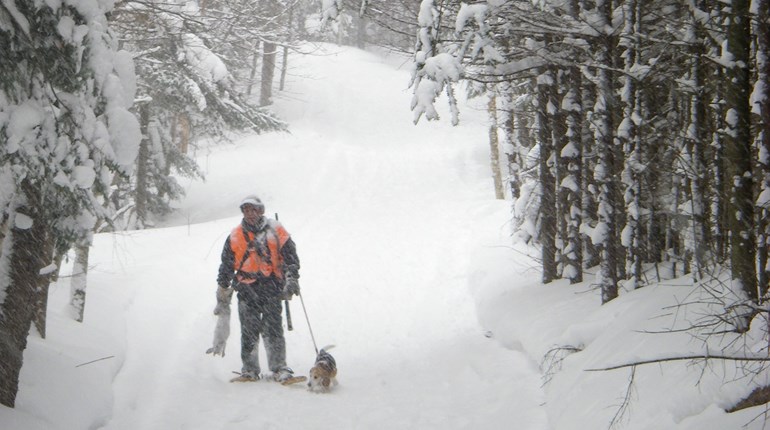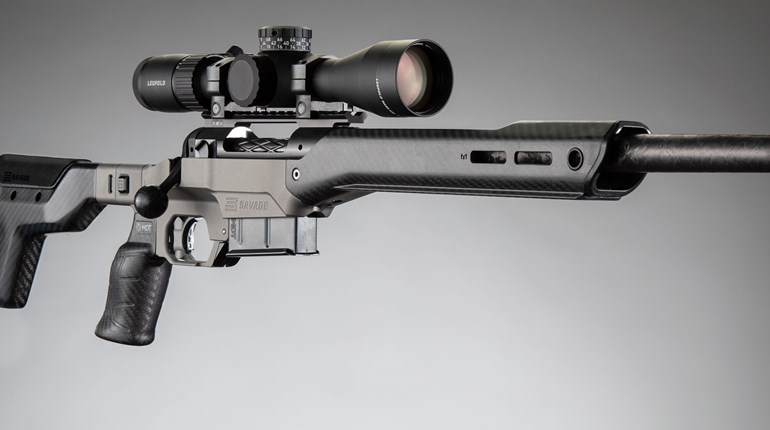
The plate rack. What is more common on the shooting range than this iconic target array? Six 8-inch round steel targets set 14 inches on center. (Twenty inches, if it’s going to be used in Bianchi Cup competition.) Hit one and it falls down out of sight.
This target is in almost every USPSA and 3-gun match and on most training ranges. It’s one of the most widely used target systems for skill building in defensive tactical shooting and for competition. Rifle, pistol or shotgun; the plate rack works with all of them.
Traditionally, the plate rack with its falling targets is used to teach rapid target acquisition. With the disappearing target, the shooter is forced to move to the next target, which builds those skills. If they want to shoot fast, it also forces shooters to trust in their skill so they don’t wait to see if they hit the target. Shoot and move to the next target and you will gain speed. How much speed? Top pistol competitors can react to the buzzer, draw and hit all six plates in 2.5 seconds. A few are even faster. I am happy when I do it in less than 3 seconds.
With multiple, relatively small, reactive targets the plate rack opens up a wide range of training options. The defensive shooter benefits because the 8-inch circle in the upper chest is the “kill” zone on a bad guy. If you can keep all your shots on a plate rack target, you can keep them in the right place in a defensive situation. Any shooter benefits because the small target requires you to focus on aiming.
The number of drills with a plate rack are limited only by your immigration. Of course, the burn-it-down drill is traditional. That is to knock them all down as fast as possible. It’s harder than you think because they are relatively small targets. The tendency is to start strong, get cocky and push harder, lose focus and miss the last targets. Adding distance adds a degree of difficulty. If you think it’s easy, move your pistol target to 50 yards and the rifle to 250 yards. I’ll bet your times start to change.
Plate racks are a bit expensive and are usually purchased by the shooting club or range. However, a few shooting buddies getting together and sharing the expense make them affordable for virtually any shooter.
I have several places where I shoot, including two different club ranges and three private-land locations. Most of them are used by other shooters and if you leave your steel targets at the range, some fool will shoot them with the wrong gun and damage the steel. I also like the ability to take the targets with me as I don’t know which range I’ll be using day to day. The problem with a plate rack is portability. They are big, heavy targets and are difficult to move.
The best plate rack system I have found for shooters like me who want to the option of mobility is the MGM plate rack and trailer system. I have been using one for a couple of years now and love the portability. Most of the time it sits at my backyard range where I can work on shooting skills during my lunch break. However, I can quickly hook up to my truck and haul it anywhere I am going to shoot. I have take it to 3-gun matches miles away from my home, as well as to family shooting days in a relative’s rural backyard. It sets up and tears down in minutes.
Here are my favorite drills with a plate rack target.
Pistol
Reload drill | 15 yards.
At the buzzer, draw and shoot two targets. Reload, shoot two targets. Reload and shoot the last two.
Reloads are from your magazine carry gear. If you are trying to build competitive skill use your competitive rig. If your goal is to build tactical skills, reload from your carry ammo as you carry it concealed.

This drill builds skills in reloading and in target acquisition. The difficulty is in doing a fast reload, which means you can’t wait for the plate to fall. Trust your skill and start the reload as soon as you break the shot. The other skill is reacquiring the target after the reload. You must shift your focus and your vision from the pistol back to the target.
The top competitive shooters can do this in around 5 seconds. Ten is a realistic goal for normal humans with a semi-auto pistol. Of course, tactical shooters reloading with concealed magazines will see even longer times, and with revolvers it’s off the chart. The goal is to be smooth, clean and to continue to improve on your times.
You are not limited to semi-autos, but this is a frustrating drill for those of us who carry a J-frame revolver and speedstrips. It does teach the limitations of that popular carry option as well as building skills with the gun. The plate rack is an eye-opener with a J-frame. Five shots go fast and leave one target standing. That illustrates the limitation of this popular handgun. Speed loaders are the fastest way to recharge the gun, while loading from a speedstrip makes watching grass grow seem like an action event.
Shoot the Ends | 15 yards
At the buzzer, draw and shoot the two outside targets. Continue shooting the target at each end alternating back and forth, until they are all down. The sequence will be 1-6-2-5-3-4.
This builds target-acquisition skills with the always changing spacing on the targets. With the decreasing distances between the targets the split time between shots should grow progressively shorter as the distance between targets grows smaller.
The top shooters can do this in 5 seconds from the holster. Seven seconds is a realistic goal.

Shotgun
Load 12 | 15 yards
This drill was developed by one of the top 3-gun competitors, Keith Garcia, and is a standard for building shotgun shooting and manipulation skills. It requires a shotgun capable of holding at least eight rounds in the magazine. If your shotgun holds less you can modify the drill by loading two instead of four rounds each time. Three-gun and tactical shotgun competitive shooters use four rounds, as the preferred loading technique is to grab four rounds each time. A defensive shooter practicing tactical use of the shotgun can load two.
Start with two rounds in the shotgun. At the beep, shoot one target, load four rounds. Shoot two targets, load four rounds. Shoot two targets, load four rounds. Shoot the final target.
Garcia does it in less than 10 seconds. I am pretty happy if I can do it faster than 15 seconds, loading from my 3-gun ammo holders. When loading a tactical shotgun from an ammo source other than a competition rig, of course, the times are slower. The key is to learn to manipulate the gun and loading technique smoothly and to continuously improve your time until you have mastered the drill.
Tactical Load | 15 yards
This is a great drill with any tactical shotgun, semi-auto or pump action.
Start with an empty shotgun and at least six rounds of ammo stored in your preferred location. This is best done with the ammo carried the way you would carry it for a tactical situation.
At the beep, load one round, shoot a plate, load the next round and shoot the next plate until all six plates have been hit. Technique is the shooter’s choice, but load only one round at a time.
This drill builds the loading and shooting skills needed in a tactical situation when the gun is empty, but the action is not over. Competitive shooters also build skills for those stages where you need one last shot.
Times vary greatly here. My goal is to record my time the first time through and then repeat the drill until I can do it 30 percent faster.

Rifle
Make sure that your plate rack is rifle-rated. It should be AR500 or AR550 steel. Impact velocity should be below 2,800 fps to avoid target damage. Mike Gibson at MGM targets recommends having a set of plates dedicated to rifle use as almost any rifle impact will dimple the steel. It’s easy to swap out the targets and it keeps it safe. If there is target damage from inappropriate rifle ammo or an accumulative effect from long-term use, it can create the danger of bullet splash-back for close-range pistol shooters.
For close drills, frangible rifle ammo is the safest option. However, impact velocity is still critical as even frangible ammo can damage steel targets if the impact velocity is high enough.
Long-Range Speed | 200 yards
This is a simple drill that will make you howl at the moon in frustration. The shooter starts standing with a loaded rifle at the low ready.
At the buzzer, the shooter engages all six targets and shoots until they are all down. The position is the shooter’s choice.

This builds skills and speed in precision shooting. If you are good enough to do this offhand, you have my admiration. Most shooters will drop to prone or sitting.
I have seen this done in 5 seconds by some of the best shooters on the planet. Me? If I can do it in 10 seconds I am ecstatic. But, the truth is I am seldom happy. Most shooters will do well to finish this in 20 seconds the first time they try it.
For an added twist, have the shooter sprint 25 yards before picking up the rifle and shooting.
1-3-6-5-2-4 | 50 Yards
At the buzzer, shoot the targets in that numerical order. Or any other random order as you can mix it up anyway you want. It’s best to have two shooters taking turns, one timing and there other shooting. The non-shooter calls the numbers before starting the timer.
The idea is to confuse the shooter, make them slow down and think. Frangible ammo is best for this drill due to the close proximity of the targets. Without frangible, 75 yards is a safer distance.
This drill builds skills for shooting and thinking under pressure. It’s a good tactical drill because it forces the shooter to think about something other than the next shot. Five seconds is outstanding, 10 is realistic. In fact, shooting a clean one-shot/one-plate drill is usually my primary goal.
For you OODA Loop disciples, this will build and strengthen those skills and focus as a shooter.




































